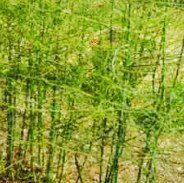Asparagus
"Liebig, or some other scientist maintains that asparagin—the alkaloid in asparagus-develops form in the human brain: so, if you get hold of an artistic child, and give him plenty of asparagus, he will grow into a second Raffaelle!"
Added Jun 12, 2010
| 9,377 Reads
The Asparagus, belonging to the Lily order of plants, occurs wild on the coasts of Essex, Suffolk, and Cornwall. It is there a more prickly plant than the cultivated vegetable which we grow for the sake of the tender, edible shoots. The Greeks and Romans valued it for their tables, and boiled it so quickly that velocius quam asparagi coquuntur—"faster than asparagus is cooked"—was a proverb with them, to which our "done in a jiffy" closely corresponds. The shoots, whether wild or cultivated, are succulent, and contain wax, albumen, acetate of potash, phosphate of potash, mannite, a green resin, and a fixed principle named "asparagin." This asparagin stimulates the kidneys, and imparts a peculiar, strong smell to the urine after taking the shoots; at the same time, the green resin with which the asparagin is combined, exercises gently sedative effects on the heart, calming palpitation, or nervous excitement of that organ. Though not producing actual sugar in the urine, asparagus forms and excretes a substance therein which answers to the reactions used by physicians for detecting sugar, except the fermentation test. It may fairly be given in diabetes with a promise of useful results. In Russia it is a domestic medicine for the arrest of flooding. Asparagin also bears the chemical name of "althein," and occurs in crystals, which may be reduced to powder, and which may likewise be got from the roots of marsh mallow, and liquorice. One grain of this given three times a day is of service for relieving dropsy from disease of the heart. Likewise, a medicinal tincture is made from the whole plant, of which eight or ten drops given with a tablespoonful of water three times a day will also allay urinary irritation, whilst serving to do good against rheumatic gout. A syrup of asparagus is employed medicinally in France: and at Aix-les-Bains it forms part of the cure for rheumatic patients to eat Asparagus. The roots of Asparagus contain diuretic virtues more abundantly than the shoots. An infusion made from these roots will assist against jaundice, and congestive torpor of the liver. The shrubby stalks of the plant bear red, coral-like berries which, when ripe, yield grape sugar, and spargancin. Though generally thought to branch out into feathery leaves, these are only ramified stalks substituted by the plant when growing on an arid sandy soil, where no moisture could be got for the maintenance of leaves. The berries are attractive to small birds, who swallow them whole, and afterwards void the seeds, to germinate when thus scattered about. Thus there is some valid reason for the vulgar corruption of the title Asparagus into Sparrowgrass, or Grass. Botanically the plant is a lily which has seen better days. In the United States of America, Asparagus is thought to be undeniably sedative, and a palliative in all heart affections attended with excited action of the pulse. The water in which asparagus has been boiled, if drunk, though somewhat disagreeable, is beneficial against rheumatism. The cellular tissue of the plant furnishes a substance similar to sago. In Venice, the wild asparagus is served at table, but it is strong in flavour and less succulent than the cultivated sort. Mortimer Collins makes Sir Clare, one of his characters in Clarisse say: "Liebig, or some other scientist maintains that asparagin—the alkaloid in asparagus-develops form in the human brain: so, if you get hold of an artistic child, and give him plenty of asparagus, he will grow into a second Raffaelle!" Gerard calls the plant "Sperage," "which is easily concocted when eaten, and doth gently loose the belly." Our name, "Asparagus," is derived from a Greek word signifying "the tearer," in allusion to the spikes of some species; or perhaps from the Persian "Spurgas," a shoot. John Evelyn, in his Book of Salads, derives the term Asparagus in easy fashion, ab asperitate, "from the sharpness of the plant." "Nothing," says he, "next to flesh is more nourishing; but in this country we overboil them, and dispel their volatile salts: the water should boil before they are put in." He tells of asparagus raised at Battersea in a natural, sweet, and well-cultivated soil, sixteen of which (each one weighing about four ounces) were made a present to his wife, showing what "solum, coelum, and industry will effect." The Asparagus first came into use as a food about 200 B.C., in the time of the elder Cato, and Augustus was very partial to it. The wild Asparagus was called Lybicum, and by the Athenians, Horminium. Roman cooks used to dry the shoots, and when required these were thrown into hot water, and boiled for a few minutes to make them look fresh and green. Gerard advises that asparagus should be sodden in flesh broth, and eaten; or boiled in fair water, seasoned with oil, pepper, and vinegar, being served up as a salad. Our ancestors in Tudor times ate the whole of the stalks with spoons. Swift's patron, Sir William Temple, who had been British Minister at the Hague, brought the art of Asparagus culture from Holland; and when William III. visited Sir William at Moor Park, where young Jonathan was domiciled as Secretary, his Majesty is said to have taught the future Dean of St. Patrick's how to eat asparagus in the Dutch style. Swift afterwards at his own table refused a second helping of the vegetable to a guest until the stalks had been devoured, alleging that "King William always ate his stalks." When the large white asparagus first came into vogue, it was known as the "New Vegetable." This was grown with lavish manure and was called Dutch Asparagus. For cooking the stalks should be cut of equal lengths, and boiled standing upwards in a deep saucepan with nearly two inches of the heads out of the water. Then the steam will suffice to cook these tender parts, whilst the hard stalky portions may be boiled long enough to become soft and succulently wholesome. Two sorts of asparagus are now grown— the one an early kind, pinkish white, cultivated in France and the Channel Islands; the other green and English. At Kynance Cove in Cornwall, there is an island called Asparagus Island, from the abundance in which the plant is found there. In connection with this popular vegetable may be quoted the following riddle:— "What killed a queen to love inclined,
Added Jun 12, 2010
| 9,377 Reads
Share The Magic ...
The GoE MONEY!!! Course - A Course In Real MONEY MAGIC!
|





















